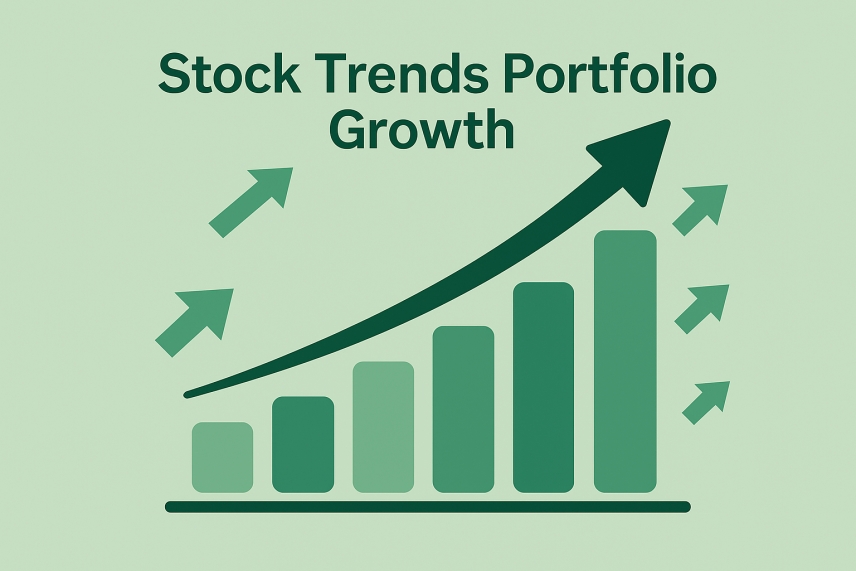Stock Trends model portfolios translate the core principles of the Stock Trends Handbook into systematic investment strategies. Each portfolio is built on the same foundation: objective price trend classifications, moving average crossover behaviour, volume indicators, and relative strength measures. These models apply the Stock Trends indicators consistently across decades, allowing investors to see how disciplined, rules-based trend following performs through complete market cycles.
By examining weekly valuation histories, we can compare the compounded annual growth rate (CAGR) of every active strategy to its relevant benchmark. CAGR is the industry standard for evaluating long-term performance because it captures the full compounding effect of gains over time. The results highlight where the Stock Trends methodology has been most effective, and how investors can interpret current strategy signals within that broader historical context.
| Portfolio | Benchmark | Years | Portfolio CAGR (%) | Benchmark CAGR (%) | Excess CAGR (%) |
|---|---|---|---|---|---|
| ETF Bullish Crossovers w/Momentum | S&P 500 | 17.1 | 26.5 | 12.2 | 14.2 |
| NASDAQ Portfolio #2 | S&P 500 | 35.8 | 14.9 | 8.7 | 6.2 |
| S&P/TSX 60 Bullish Crossover | S&P/TSX Composite | 31.2 | 14.5 | 6.4 | 8.1 |
| NYSE Portfolio #2 | S&P 500 | 35.7 | 13.4 | 8.8 | 4.6 |
| NASDAQ 100 Bullish Crossover | S&P 500 | 34.9 | 13.2 | 9.1 | 4.2 |
| NYSE ST-IM Select Bullish Crossover | S&P 500 | 21.8 | 12.9 | 8.5 | 4.4 |
| TSX Portfolio #1 | S&P/TSX Composite | 32.0 | 10.4 | 6.2 | 4.1 |
| S&P 100 Bullish Crossover | S&P 500 | 44.8 | 10.6 | 9.1 | 1.5 |
| TSX Financials Bullish Crossover | S&P/TSX Composite | 31.1 | 10.5 | 6.5 | 4.1 |
| NYSE Weak Bearish Breakout | S&P 500 | 35.8 | 10.0 | 8.7 | 1.4 |
| TSX Portfolio #2 | S&P/TSX Composite | 31.2 | 8.7 | 6.5 | 2.2 |
| TSX Weak Bearish Breakout | S&P/TSX Composite | 31.8 | 8.3 | 6.1 | 2.2 |
| TSX Bullish New High | S&P/TSX Composite | 31.2 | 7.7 | 6.4 | 1.4 |
| Dow Jones Industrials Bullish Crossover | S&P 500 | 44.8 | 7.7 | 9.1 | -1.4 |
| NASDAQ Portfolio #1 | S&P 500 | 35.5 | 6.8 | 8.7 | -1.9 |
| NASDAQ ST-IM Select Bullish Crossover | S&P 500 | 21.8 | 6.3 | 8.6 | -2.3 |
| NASDAQ Weak Bearish Breakout | S&P 500 | 35.8 | 6.3 | 8.8 | -2.5 |
| TSX ST-IM Select Bullish Crossover | S&P/TSX Composite | 21.2 | 5.9 | 6.2 | -0.4 |
| NYSE Portfolio #1 | S&P 500 | 34.9 | 1.9 | 9.1 | -7.1 |
| NASDAQ Bullish New High | S&P 500 | 35.8 | 0.0 | 8.6 | -8.6 |
Strategies with the strongest long-term outperformance
Several strategies stand out for delivering exceptional compound returns relative to their benchmarks. Foremost among them is the ETF Bullish Crossovers with Momentum portfolio, which has achieved approximately 26.5% CAGR since 2008—more than double the long-term growth rate of the S&P 500. The addition of a momentum overlay to bullish crossovers amplifies the core lesson of the Stock Trends indicators: strong trends, when reinforced by persistent price behaviour, deliver superior long-term outcomes.
Among broad index strategies, the S&P/TSX 60 Bullish Crossover continues to be one of the strongest performers, compounding at about 14.5% annually for over three decades. Its U.S. counterpart, the NASDAQ 100 Bullish Crossover, has similarly delivered approximately 13.2% CAGR, far exceeding the S&P 500 over the same horizon. These models demonstrate the effectiveness of trend classification when applied to large, liquid index constituents.
Two of the broad market equity strategies—NASDAQ Portfolio #2 and NYSE Portfolio #2—both show long-term CAGR above 13%, outperforming their S&P 500 benchmark. These second-generation portfolios apply more selective trend-entry criteria than their Portfolio #1 counterparts, reflecting a principle emphasized in the Handbook: disciplined entry filtering can have a meaningful effect on long-term portfolio quality.
The NYSE ST-IM Select Bullish Crossover also remains a top performer, compounding at nearly 13% annually over 22 years. Incorporating the Stock Trends Inference Model (ST-IM) enhances the selection process by emphasizing stocks with higher statistical probabilities of outperforming their benchmarks.
TSX Portfolio #1 has achieved approximately 10.4% CAGR over more than 32 years, compared to about 6.2% CAGR for the S&P/TSX Composite during the same period. This represents more than 4 percentage points of annualized outperformance.
TSX Portfolio #1 illustrates the long-term value of applying the Stock Trends indicators consistently to Canadian equities—even in the absence of a fixed capital allocation model. The synthetic valuation approach makes its performance comparable to the other strategies and confirms that TSX Portfolio #1 delivers meaningful positive excess returns.
Mid-range and benchmark-like performers
Some strategies cluster around benchmark-level returns. These include the Dow Jones Industrials Bullish Crossover, S&P 100 Bullish Crossover, TSX ST-IM Select Bullish Crossover, and NASDAQ Portfolio #1. While their CAGR results are close to their respective benchmarks, they still offer practical instructional value: they reveal how varying degrees of selectivity within the Stock Trends framework yield different long-term outcomes.
These portfolios help investors see how weaker or less persistent trend conditions lead to more modest results. They function effectively as “confirmation models,” especially when viewed alongside the stronger-performing crossover or momentum-based strategies.
Strategies that have lagged their benchmarks
A small group of strategies—including NYSE Portfolio #1 and the NASDAQ Bullish New High Portfolio—lag their benchmarks over their full histories. The New High strategy in particular shows minimal long-term compound growth despite producing periodic bursts of momentum. This aligns with the Handbook’s caution that new highs alone do not guarantee durable trend behaviour, especially in more volatile market universes.
Interpreting buy and sell signals today
The long-term performance results emphasize a core principle for current users: trend-following is most effective when entries and exits are applied with discipline. Signals generated by the strongest-performing strategies—such as the ETF Momentum model, the NASDAQ 100 Bullish Crossover, or the S&P/TSX 60 Crossover—carry meaningful historical weight. When these models produce a buy signal, it reflects bullish conditions that have historically yielded significant outperformance.
Conversely, signals from strategies with weaker long-term results should be viewed as supplementary rather than primary. Investors may use them to confirm broader trend conditions, but not as standalone triggers.
Conclusion
The complete portfolio set continues to affirm a central message: the Stock Trends indicators provide a durable and practical framework for interpreting market behaviour. Across multiple markets, sectors, and universes, strategies based on bullish crossovers, momentum reinforcement, and selective trend filtering have consistently delivered strong long-term results.
These portfolios remain valuable tools for subscribers: systematic, rules-based interpretations of trend conditions that frame investment decisions with clarity, discipline, and historical perspective.
Addendum: Understanding the Difference Between CAGR and the Portfolio Performance Summary ROI
Readers may notice that the annualized performance figures calculated from the long-term valuation history of the Stock Trends portfolios differ from the “Average Annual Return on Investment (ROI)” reported in the Portfolio Performance Summary tables on the StockTrends.com website. These two measures are often mistaken as equivalent, but they are based on fundamentally different methods of performance calculation. Understanding this distinction is essential for accurate interpretation of the model portfolios.
1. CAGR – Compound Annual Growth Rate
The CAGR figures used in the long-term analysis of portfolio valuations measure the compounded growth of the total portfolio value from its inception to the current week. This approach answers a straightforward question:
“At what annual rate would the portfolio have needed to grow, with full compounding, to reach its current valuation from its initial value?”
CAGR reflects:
- compound growth of all gains,
- reinvestment effects,
- changes in the number of holdings over time,
- portfolio scaling as profits accumulate.
This is the method typically used in performance reporting for investment funds, indexes, and wealth management accounts, as it captures the full compounding effect inherent in portfolio-level returns.
2. Stock Trends Website ROI – Return on Average Weekly Investment
The ROI figure shown in the Portfolio Performance Summary on the website uses a different framework. Instead of tracking the compounded growth of portfolio valuation, it calculates:
“How much profit the portfolio generated per dollar of average capital invested, per year, without compounding.”
The calculation is based on:
- Total net gains (realized and unrealized),
- Average weekly investment cost – computed using the average number of positions held and the average net cost per position,
- Number of years between the first and last position.
This ROI method is a linear measure of profitability, not a compounded growth rate. It reflects the portfolio’s operational efficiency in generating returns on deployed capital, rather than the compounded return of the portfolio’s total valuation.
3. Why the Numbers Differ
Because the website ROI is a non-compounded, average return per invested dollar, and CAGR measures compounded portfolio growth, the two values will naturally differ. CAGR is almost always higher for portfolios with:
- significant reinvested gains,
- growing position sizes,
- long holding periods,
- a rising number of positions over time.
For example, the U.S. ETF Bullish Crossover Portfolio has a long-term CAGR of approximately 26.5%, reflecting the compounded growth of total portfolio valuation since 2008. In contrast, the website’s “Average Annual ROI” for this portfolio is approximately 6.8%, representing the average return generated per dollar of weekly invested capital, without compounding.
4. How to Interpret the Two Measures
Both measures are useful, but they serve different analytical purposes:
- CAGR – best for evaluating long-term portfolio performance relative to benchmarks such as the S&P 500 and TSX Composite.
- Website ROI – best for evaluating the efficiency of the strategy’s capital deployment, independent of compounding effects.
When assessing the strength of a Stock Trends strategy, investors should rely primarily on the CAGR and benchmark-relative comparisons, ensuring consistency with industry-standard measures of portfolio performance.


 I've followed your recommendations since reading your columns in the Globe & Mail, and finding they published Stock Trends arrows in their financial listings. I do find them a guide to the general market and what I should be avoiding for declining chart trends.
I've followed your recommendations since reading your columns in the Globe & Mail, and finding they published Stock Trends arrows in their financial listings. I do find them a guide to the general market and what I should be avoiding for declining chart trends.


